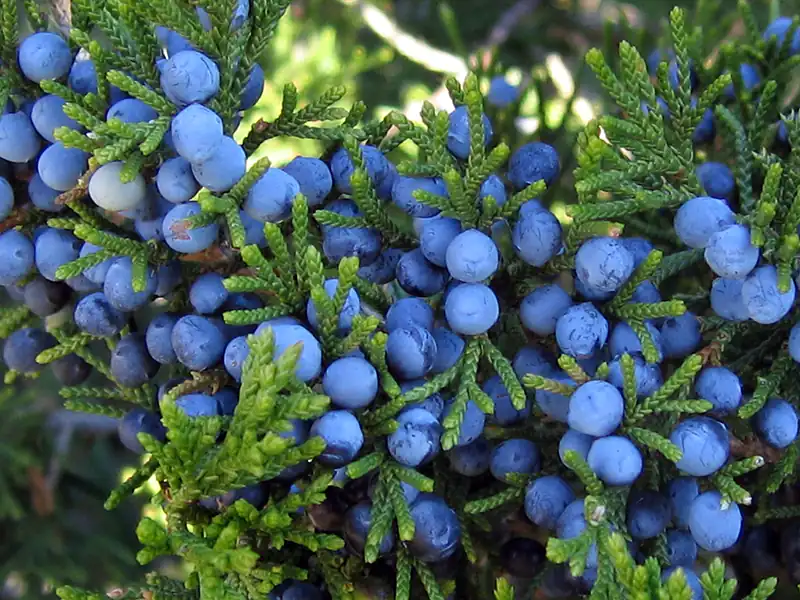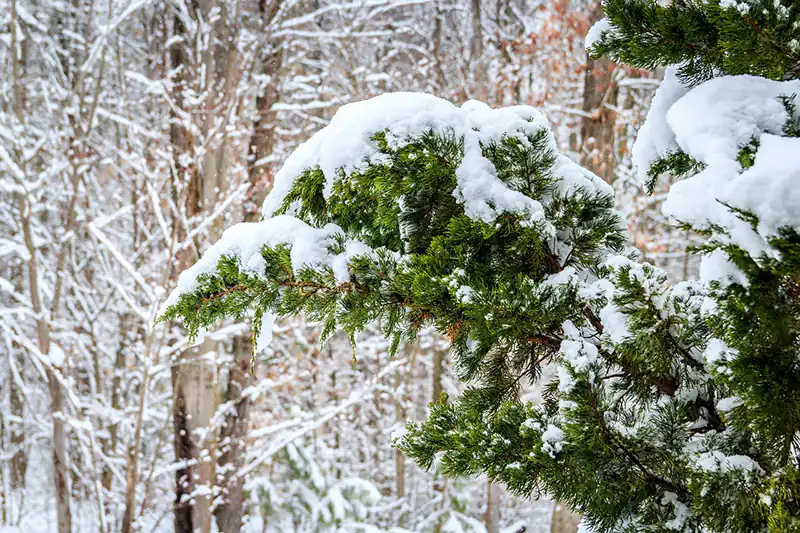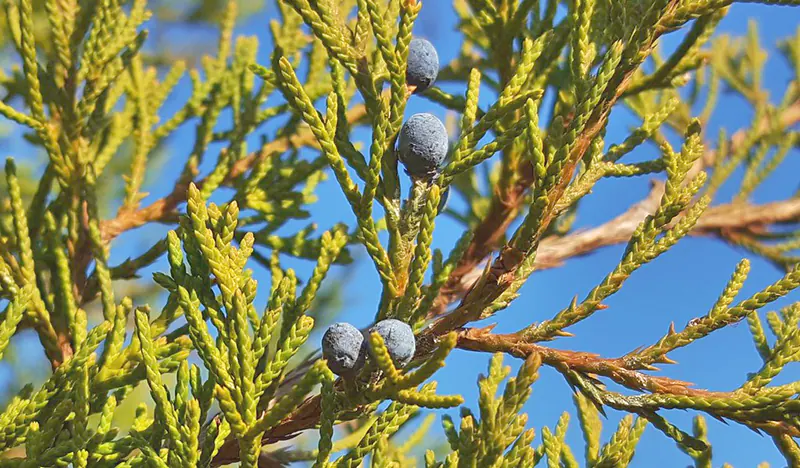Red Cedar Juniper Bonsai
Juniperus virginiana
The red cedar juniper is a gorgeous evergreen tree to turn into a bonsai. In this care sheet, we’ll detail how to raise it, which propagation methods work best, and if you can grow it indoors. Red cedar junipers are tall, turning into large bonsai with distinct shapes that make them easy to maintain. Image courtesy of 4.0 International
Image courtesy of 4.0 International
In our red cedar juniper care guide, you'll find:
In our red cedar juniper care guide, you'll find:
01
02
03
04
05
Quick Red Cedar Juniper Bonsai Care Sheet
Here’s a brief overview of the care specifics you need to know when growing a red cedar juniper bonsai tree.
Recommended soil
Normal bonsai mixed soil that has good drainage works well for this tree.
Watering
Water to keep the soil moist, but not soaked.
Potting season
Repot a young plant every other year and older plants every
Shaping and pruning season
Prune when repotting or in warmer seasons, shape with wires near the end of autumn.
Light
Full day of sun, if possible, can survive partial sunlight exposure.
Fertilizing
Fertilize every 20 to 30 days with a 20-20-20 fertilizer. Avoid fertilizing during summer’s hottest days and during winter.
Propagation methods
Cuttings or layering.
Pests and diseases
Scales, bagworm caterpillars, mites, twig blights, lesions, and various rusts.
Growth patterns
Vigorous growth in spring, and sometimes more in fall
Recommended styles
Slanted
How to Care for a Red Cedar Juniper Bonsai
Caring for any bonsai tree can be confusing. Here’s the need to know the information to know before you start growing your own red cedar juniper bonsai tree. We explain the best soil, watering habits, location, and various other details that will help your plant thrive.
Best Soil
The best soil for a red cedar juniper is a well-draining mix. Most common bonsai soil will work well as they don’t hold too much water. These mixtures allow both soil and air to reach your tree’s roots.
Watering
Keep the red cedar juniper’s soil damp, watering only when the top half-inch is dry. Watering more frequently than this will damage the plant’s roots. As you water the bonsai, gently mist water over its foliage to help it during the growing season.
Repotting
When repotting, prune the roots gently. Slowly cut the roots until you’ve cut off up to a third of their size. Repotting trees below ten years of age should be done every second year. Once the tree is older, you’ll need to repot it every three to four years. Protect the bonsai for a month after repotting it.
Shaping and Pruning
Shape your tree using wires near the end of autumn. This method will allow the plant to adjust and set its branches while dormant. If you wire the red cedar juniper during any other season, watch out for damage to the bark.
Prune unwanted branches when you repot or during the warmer seasons.
Location and Sunlight
Place the red cedar juniper outdoors in an area that receives a full day of sun. The plant can survive without a full day’s worth of sunlight and in partial shade but benefits greatly from as much exposure as possible.
In winter, the plant can survive at temperatures between 25 to 45 degrees Fahrenheit as it enters dormancy. However, if your area dips below this, you may need to shelter the bonsai during winter.
Fertilizing
Fertilize the red cedar juniper in early spring to autumn using a slow-acting fertilizer. Feeding the bonsai should occur between twenty to thirty days to avoid overfeeding and harming your tree. Avoid fertilizing during the hottest summer days or within two weeks of repotting the tree. Additionally, don’t fertilize the bonsai during the winter months as it goes dormant and won’t grow.
When fertilizing, use a 20-20-20 fertilizer for optimal effect.
Propagation Methods
The red cedar juniper can be propagated with cuttings. Alternatively, layering also works to propagate this species of bonsai. As the plant goes dormant in the winter, it’s best to wait until spring before beginning this process.
Pests and Diseases
The red cedar juniper is vulnerable to multiple pests and diseases. When caring for this bonsai, watch out for bagworm caterpillars, scales, and mites. These pests can affect your bonsai’s foliage and cause it harm.
Aside from pests, the red cedar juniper is vulnerable to diseases. Watch out for twig blights, small lesions, kabatina blight, cedar-apple rust, hawthorn rust, and quince rust.
Recommended Styles
The red cedar juniper is often presented in a slanted style that shows off the tree’s trunk. This style makes the tree lean past its pot and take up a large area.
Considerations for Growing an Indoor Red Cedar Juniper
Not every bonsai tree is suited for indoor growth; many thrive when placed outside and receive a full day of direct sunlight. Here’s what you need to know if you want to grow your red cedar juniper indoors. We don’t recommend growing this species inside your house.
Sunlight
The red cedar juniper requires a full day’s worth of sunlight. Growing this tree indoors will lessen the amount of direct sunlight it receives, slowing its growth and risks killing the plant if it doesn’t see enough sun at all.
If you want to grow the red cedar juniper indoors, you’ll need to place it by a sun-facing window and move it periodically to ensure it receives plenty of light.
Winter Seasons
In the winter, you’ll need to keep watch on your house’s temperature if you want to grow the red cedar juniper indoors. In the colder months, the plant enters a state of dormancy. The bonsai enter’s this state when temperatures are between 25 to 45 degrees Fahrenheit.
While dormant, you’ll need to water the tree as needed. However, you shouldn’t use fertilizer or repot the tree during this season.
Common Issues When Caring for a Red Cedar Juniper Bonsai
When growing a bonsai tree, it’s not uncommon to have issues and hiccups during the plant’s growth. The most common areas of concern are when growing a red cedar juniper bonsai tree.
Sunlight
Requiring a full day of sun, the eastern red cedar needs to be placed outdoors. The plant can survive with partial sunlight exposure throughout the day. However, the bonsai will grow slightly slower than it normally would with less sun.
Soil Wetness
When watering, you need to ensure that the soil is always damp. Before water or dry soil, dip your finger half an inch into the soil. If the soil’s still wet before half an inch, you shouldn’t water the tree. Ensure that the soil isn’t fully dry or soggy.
Winter Temperatures
Depending on your location, winter may severely impact your red cedar juniper’s health. In winter, this tree enters dormancy. As long as the temperature isn’t below 25 degrees Fahrenheit, your bonsai will survive. If the temperature in your local area goes below this, you’ll need to move the tree to a warmer area.
Image courtesy of 4.0 International
FAQs About Red Cedar Juniper Bonsai
If our care sheet didn’t answer your questions about the red cedar juniper, here are commonly asked items. These five questions will explain the growth pattern, watering frequency, and ease of turning the tree into a bonsai. We’ll also explain the red cedar’s relation to its juniper species.
The red cedar tree can grow between one and one and a half feet per year. This height reaches a maximum of 30 to 35 feet in its life. However, this amount of growth is much more limited for a bonsai.
Red cedar can grow up to an average height of 30 to 35 feet. While this height is much more limited for bonsai trees, your plant can still reach massive heights given enough time. The average growth rate for a red cedar juniper is between one and one and a half feet per annum.
Red cedars are easy to turn into a bonsai and can be propagated from cuttings or layering. The tree requires plenty of sunlight and moist soil to grow as a bonsai.
The red cedar juniper can grow indoors and thrives outdoors as it’s generally a hardy plant. However, in both locations, you need to pay attention to the amount of sunlight the plant receives and your watering frequency. It’s essential to keep the bonsai in full sun or part shade.
Water the red cedar juniper bonsai while the soil is moderately dry. It’s best not to wait for the soil to completely dry, giving a half-inch of dryness before watering. During the growth stage, lightly spray water over the tree each day.







